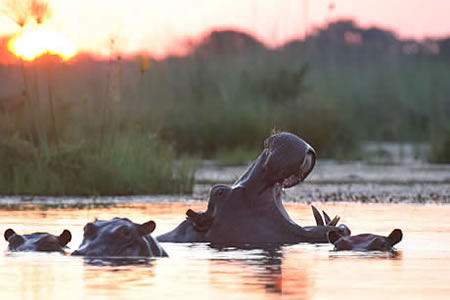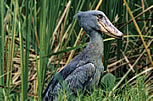![]()
Uganda Queen Elizabeth Park

Vacationtechnician personalized luxury adventure travel transports you to the most exquisite wilderness and chill out retreats on Earth. Conserving rare biodiversity through low volume tourism; our aim is your indulgence -at no one's expense. Plan now to be assured a rejuvenating escape at a restful pace -to an unspoilt gem in the purest sense.
'The Pearl of Africa', as Winston Churchill dubbed Uganda at the beginning of the century, now seems something of a misnomer for a country that continues to hit the world's headlines with bad news. During the last decade, however, Uganda has regained some stability and, despite the damage that has been done, the protected areas are recovering. One of these is the Queen Elizabeth National Park.
Uganda, once one of East Africa's prime tourist destinations, has struggled during the last decade to re-establish itself as a country worth visiting. Years of civil war and tales of atrocities damaged its reputation and then, just as it seemed that tourism once again stood a chance, the brutal killing of eight gorilla-tracking foreign visitors and a warden put paid to efforts to attract tourists.
This is a shame, for Uganda boasts a true jewel: the Queen Elizabeth National Park. An area of outstanding natural beauty and home to 95 recorded mammal and 568 bird species, it is the most popular protected area in the country and only half a day's drive on good tarred roads from the capital, Kampala. Established in 1954 in the south-west of the country close to the border with the Democratic Republic of Congo (DRC), the park encompasses the crater-dotted foothills of the Rwenzori Mountains and stretches from Lake George to the shoreline of Lake Edward. This pristine area of almost 2 000 square kilometres incorporates a wide variety of habitats, ranging from savanna and wetland to gallery and lowland forests.
Water is the dominant element, giving the park its unique character, and is the reason for its diversity. The two biggest lakes in the reserve, Lake George and Lake Edward, are connected by the natural, 34-kilometre-long Kazinga Channel, which accommodates the world's densest population of hippopotamus. The number of hippos, formerly 14 000, decreased dramatically during the years of unrest (to approximately 2 000) but by 1999 had recovered to about 6 000. (Interestingly, in the 1960s the hippos were considered pests because of the vegetation they destroyed through their sheer numbers, and were routinely shot.)
Also to be found in the park are various crater lakes, other smaller lakes and their flats, and papyrus and reed swamps. The soda crater lakes seasonally attract large flocks of flamingos, while the vast marshes and swamps harbour a plethora of waterbirds, including saddle-billed stork, sacred ibis, a variety of herons, white-faced and knob-billed ducks, black crake, pelicans and scores of palaeartic shorebirds.
For birders, the most sought-after resident of the papyrus swamp is probably the shoebill, a majestically archaic-looking bird that is commonly seen in some areas, waiting motionless to ambush its fishy prey. Typical mammals to be found in this habitat are the Bohor reedbuck and the extremely shy (and therefore rarely seen) sitatunga.
The park's vegetation consists mainly of acacia and euphorbia woodland, where the most easily observed animals are the Defassa waterbuck, warthog, buffalo and bushbuck. Another inhabitant frequently seen is the giant forest hog, which normally lives in dense forests and is known to be rather shy.
Elephants tend to congregate around permanent water sources in the dry season, although they can also be observed year round. The distributions of the savanna elephant and the smaller forest elephant subspecies, with its straight tusks, overlap in the park, so both types can be found here. Like the hippos, the elephants suffered devastating losses during the country's troubles: only 200 of an original 6 000 animals survived. Today approximately 2 000 elephants live in the park, an increase due partly to the insecure situation in the adjacent Parc National des Virungas (in the DRC) which has caused many animals to flee to a safer area.
The northern part of the Queen Elizabeth National Park consists of more open, grassy plains studded with bushes, a habitat that supports a population of about 10 000 Uganda kobs. Several mating grounds, heavily contested by the males, are spread out across the plains between the kobs' grazing and watering spots. Many small territories are centred around one or more hubs and are marked by heaps of dung, with patches of urine-soaked soil to attract passing females.
The park's healthy lion population - drawn, no doubt, by the accumulation of possible prey - is best observed in this area. Another feline present is leopard, which can sometimes be seen alongside the game tracks or even inside the rest-camps. Hyaenas, too, wander through at night, so camp residents have to keep their eyes peeled for both grazing hippos and these curious carnivores.
Primates, of which the park is home to 10 species, are another big attraction. Habituated chimpanzees can be observed on a nature walk in the lushly forested Kyambura Gorge, formed by the turbulent waters of the roaring Kyambura River. This area is home to the black and white colobus and olive baboon, as well as the chimps.
Other primates, notably vervet, blue, red-tailed, D'Hoest and red colobus monkeys, are present in the Maramagambo Forest, a medium-altitude, moist semi-deciduous woodland (the last in East Africa). The name of the forest alludes to its vastness and means 'the one who is travelling in the forest is empty of words'. Interspersed within the forest are a number of tranquil crater lakes, and there is also a cave accommodating some 10 000 Egyptian rousette bats which can be heard - and smelled - from some distance away. In the cavities at the bottom of the cave lurk pythons and monitor lizards, always ready to snatch an errant bat - as are various birds of prey, including bat hawks.
The forest extends to the southern tip of the national park, the so-called Ishasha sector, named after the river bordering the DRC. Topi inhabit the grassy plains which are speckled with acacias and fig trees, but the major stars here are the tree-climbing lions. During the rainy season the lions try to escape the tsetse flies by resting in the fig trees, their fat bellies squeezed between branches.
Although in the 1960s the Queen Elizabeth National Park was famous for its abundance of mammals, periods of war and civil unrest have almost wiped it from the tourist map. It has recovered to some extent since the present government took over in 1986, and has even attracted international donors. Intrinsic problems remain, however, of which one of the most serious is the pressure placed on the land by people living in and around the park. There are 10 fishing-village enclaves (both legal and illegal) in the park itself, while an unknown number of people live along its borders. Poaching is still a problem, and over-fishing of the lakes and Kazinga Channel is also depleting the natural resources; this affects the local people as well as fish-eating birds such as the African fish eagle.
While the incumbent ranger force is an important weapon in fighting poaching and over-fishing, the park, together with international donors, has also started community projects. Changing the attitude of the local people is a slow process, however, and only time will tell how successful these efforts have been.
____
![]() 03/14/04
22:30 GMT
Uganda World Watch Advisory vacationtechnician.com
03/14/04
22:30 GMT
Uganda World Watch Advisory vacationtechnician.com
A ban on smoking in most public places took effect in Uganda March 12, 2004.
Penalties in effect. Ugandan
authorities imposed a smoking ban in all public places March 12. Smoking is
prohibited in restaurants, educational institutions, bars and other places
where people gather. Fines will range between USD 10-50.
____
UgandaReading
Africa's Pearl Uganda
Uganda's Queen Elizabeth National Park
Diversity of Endermics -Bwindi
Impenetrable Forest
Mountain Gorillas in Bwindi Impenetrable Forest, Uganda
Kidepo -Hope in Uganda
Uganda's Papyrus Specials –Birding Adventure
Pure
The Mariba Banshee (Birding)
Fishing for the Nile Perch
---------------------------------------------------
Listening • Understanding •Planning
Introduce Yourself -
Scheduled Trips - Private Safaris
- Newsletter
About Us - Our Mission
- Our Philosophy - Yacht
Charter - DryGoods
![]() We speak English
We speak English
![]() Wir sprechen Deutsch
Wir sprechen Deutsch
![]() On parle français
On parle français
![]() Parliamo italiano
Parliamo italiano
info at vacationtechnician dot com
Thanks for visiting vacationtechnician.com
Friendly•Dependable•Knowledgeable•Experienced
© 1998-2007 vacationtechnician.com All Rights Reserved




